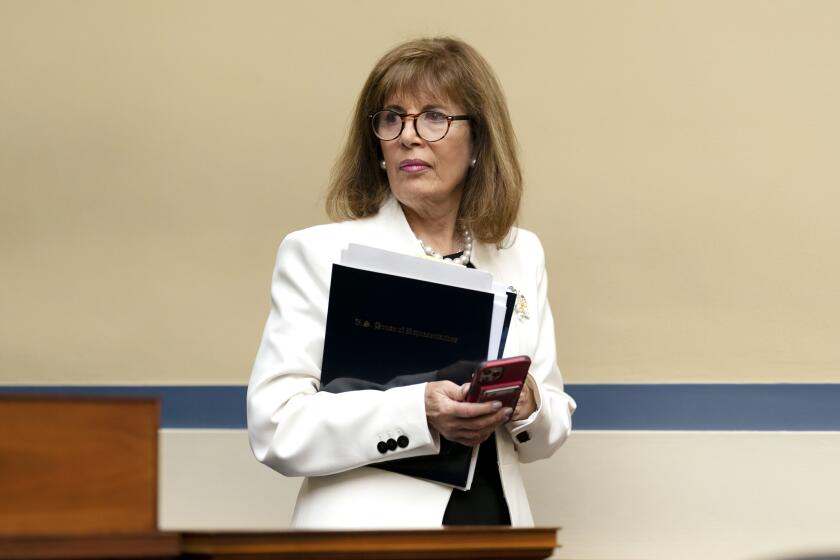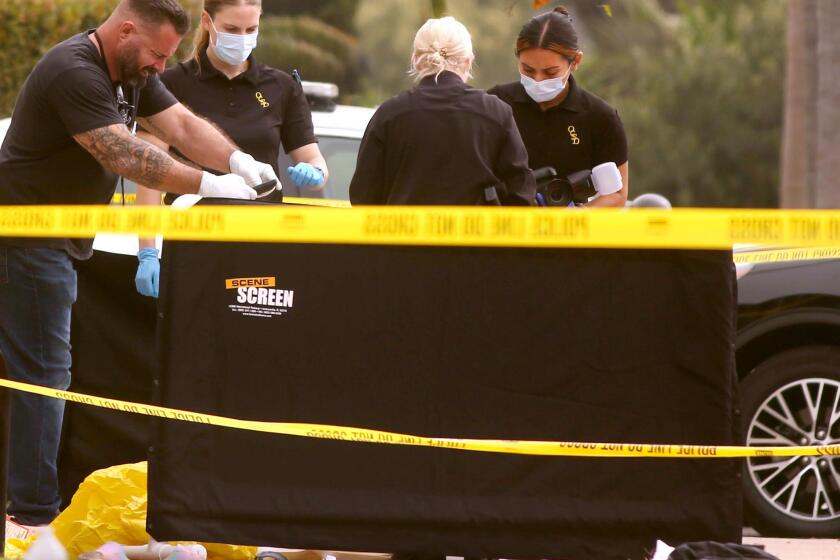Police Probe of Women Accused of Killing Men for Death Benefits Widens
Two women in their 70s charged with befriending, insuring and then killing two men for $2.5 million in death benefits tried to buy policies covering three other men, investigators said Thursday.
The women “fattened these people up like Christmas turkeys — it’s beyond bizarre,” said Los Angeles Police Det. Dennis P. Kilcoyne, the chief investigator on the case.
The three newly identified men, all described as transients, are being sought by police. They were identified by insurance companies studying their records for possible links to the alleged scheme.
Kilcoyne issued a public appeal for information about Nicolas Koos, 67; Jimmy Allen Covington, 47; and Scott B. Gones.
Earlier Thursday, the two women, Helen Golay and Olga Rutterschmidt, made their first appearance in state court.
Investigators also said evidence taken from a car linked to the women and believed to have been used to run down one of the victims contained traces of his DNA.
“Our tests of biological material came back positive with a degree of certainty beyond a number that I can count to,” said LAPD Lt. Paul Vernon.
Golay, 75, appeared in Los Angeles County Superior Court on Thursday morning wearing a blue jacket over a striped blouse, her hair parted down the middle. She appeared animated as she consulted with her lawyer, Roger Jon Diamond.
Rutterschmidt, 73, remained seated through most of the hearing; a lawyer has not yet been selected to defend her.
Their arraignment was delayed until Aug. 29 in the deaths of Paul Vados, 73, who was covered by more than a dozen life insurance policies when he was run down by a car on La Brea Avenue in 1999, and Kenneth McDavid, 50, who was covered by 23 policies when he was killed by a car.
Both women have been in custody without bail since May, when federal authorities charged them with trying to defraud insurance companies. Diamond said the federal charges were dismissed this week as federal investigators stepped aside for the more serious state murder charges.
DNA found on a silver Mercury Sable station wagon was connected to McDavid, police said.
“We found tissue in three locations on the undercarriage of the car,” Kilcoyne said. “We have records to show both women bought this car in 2004, then they stored it at Golay’s house.”
Police believe the women “drugged them with pills or alcohol first, then ran over them,” Kilcoyne said.
Diamond said his client is innocent. The evidence proves “that there was an accident involving McDavid,” Diamond said. “It doesn’t show who was driving the vehicle. Neither lady was driving the vehicle. It was a hit and run; no one knows who was driving.”
Diamond is seeking the court’s permission to represent Golay in the case. He said federal agents seized $1.2 million of her assets when she was arrested and she now cannot pay for her defense.
The three missing men were named as insured in applications filed with several companies. The applications listed Rutterschmidt and Golay as beneficiaries. For various reasons, the policies were never issued.
Police believe Rutterschmidt and Golay befriended the men — all believed to be transients — cared for them and put them up in apartments while plotting their deaths.
For the two dead men, Rutterschmidt and Golay were listed as beneficiaries in dozens of insurance policies totaling more than $7 million, according to authorities.
Kilcoyne recounted that traffic investigators noticed bizarre parallels between seemingly unrelated pedestrian deaths. Two investigators last September were talking about one old case and one current one when they realized Rutterschmidt and Golay had claimed the bodies of each man and sought documents that would trigger their benefits.
The traffic investigators approached homicide detectives with what Kilcoyne called “this far-fetched story of a couple of old women engaged in this fantastic scheme.”
Police watched each woman over many months. At the same time, state insurance investigators combed records.
“We never once saw them together, or saw them meet one another,” Kilcoyne said. “That added to the confusion.”
The defendants’ age makes capital punishment unlikely, according to Diamond.
Sandi Gibbons, spokeswoman for Dist. Atty. Steve Cooley, said a decision on whether to seek the death penalty won’t be made until the case moves closer to trial.
“Generally this is done after a defendant is held to answer at a preliminary hearing or has been indicted,” Gibbons said.
More to Read
Start your day right
Sign up for Essential California for news, features and recommendations from the L.A. Times and beyond in your inbox six days a week.
You may occasionally receive promotional content from the Los Angeles Times.






